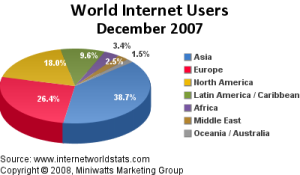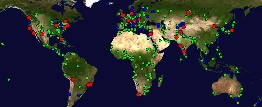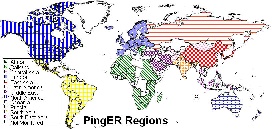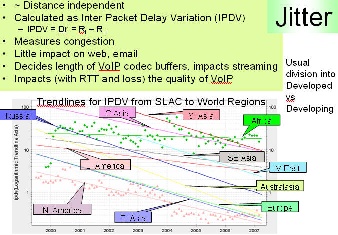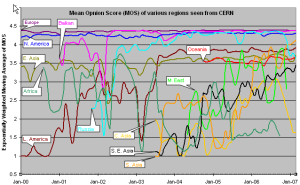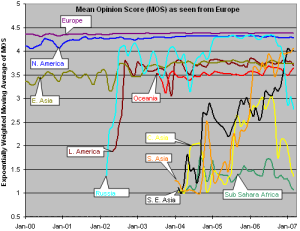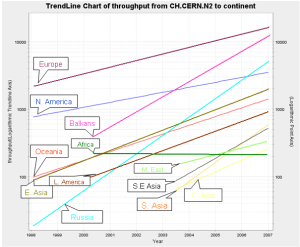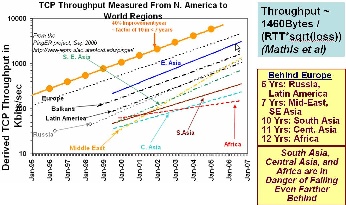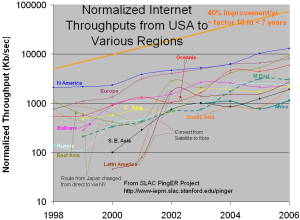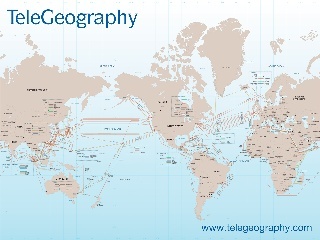Introduction
This document is a case study on the inter-regional connectivity of Eastern Asia. The figure - Eastern Asia - depicts the countries considered to be part of East Asia. These are China, Japan, North Korea, South Korea, Mongolia and Taiwan.
Here we study the current capacity, infrastructure and opportunities that the users of these countries have to access the Internet. Followed by that we analyze the Internet performance as measured by the PingER project in comparison to the world and neighbouring countries. Later we compare the performance statistics to the Human Development Indices.
Current circumstances
As shown in the following two figures, currently, Asia contributes approximately 40% of the Internet users towards the total. Among these 40%, the major contributors are some of the East Asian countries such as China, Japan, South Korea and Taiwan.
|
|
World Internet Users |
Asia Top 10 contributors towards |
|---|
This is primarily because of the high levels of Internet penetration compounded by the population. Also, the fact that these countries are densely populated, makes it easier for the telecommunication providers to extend services to large number of customers. Additionally the government policies promoting the establishment of a sound IT infrastructure has a positive impact. For example, by 2004 South Korea had spent approximately US$ 24 billion in setting up a national backbone linking government offices and public institutions. Also these same policies have encouraged competition among service providers resulting in decrease in the costs and increase in data rates. The summary is provided in Table 2 - Cost of Internet access.
On average East Asia has an Internet Penetration level of 46.74%. South Korea features the highest Internet penentration level of 71.2% with Japan and Taiwan following closely at 68.7% and 67.4%. A summary of the statistics is listed in the table below. These statistics were gathered from Internet World Statistics.
Table - 1 - East Asia Internet Usage
Asia |
Population |
Internet Users |
Internet Users |
Penetration |
% users in |
Use growth |
|---|---|---|---|---|---|---|
China |
1,321,851,888 |
22,500,000 |
210,000,000 |
15.9 % |
41.1 % |
833.3 % |
Japan |
127,433,494 |
47,080,000 |
87,540,000 |
68.7 % |
19.0 % |
85.9 % |
South Korea |
49,044,790 |
19,040,000 |
34,910,000 |
71.2 % |
6.8 % |
83.4 % |
Taiwan |
22,858,872 |
6,260,000 |
15,400,000 |
67.4 % |
3.0 % |
146.0 % |
North Korea |
23,301,725 |
- |
- |
- |
- |
0 % |
Mongolia |
2,951,786 |
30,000 |
310,000 |
10.5 % |
0.1 % |
933.3 % |
|
Summary of |
|---|
Table - 2 Cost of Internet access (source: wikipedia)
|
Cost |
Data Rate |
Type |
Estimate |
|---|---|---|---|---|
China |
US$ 10 - 20 |
1 Mbps |
DSL |
2007 |
Japan |
US$ 90 |
1 Gbps |
FTTH |
2005 |
S. Korea |
US$ 30 |
100 Mbps |
ADSL |
2004 |
International Bandwidth for East Asia
The international bandwidth for China, Japan, North Korea, South Korea, Mongolia and Taiwan are shown in the figure - International bandwidth - below. The statistics have been collected from Mike Jenson 10/18/07 - International bandwidth by country, Internet World Stats and ITU. They clearly show two groups of countries; those which have reasonable available resources (such as Japan, South Korea, Taiwan and China) and those which are lagging far behind (such as Mongolia).
|
|
|
International Bandwidth |
Central project of the |
International bandwidth |
|---|
The central projection of the Global Internet Map 2006 shows the international internet bandwidth and is scaled by capacity. The map also shows color-coded tags, indicating the number of internet hosts per 10,000 people. Each country is color-coded according to the extent of international internet bandwidth available. The maps of central projection and international bandwidth usage per country were prepared by TeleGeography.
Pinger Coverage
|
|
PingER Coverage Worldwide |
PingER Regions |
|---|
The map - PingER coverage of Eastern Asia highlights the Monitoring (Red), Beacon (Blue) and Remote (green) sites in the region. The distribution of these nodes is shown in Table - 1 below.
Table - 2 - Node Distribution in Eastern Asia
|
Monitoring |
Beacon |
Remote |
|---|---|---|---|
Japan |
1 |
1 |
9 |
China |
2 |
1 |
7 (east) |
South Korea |
1 |
1 |
4 |
Mongolia |
0 |
1 |
0 |
Taiwan |
1 |
1 |
0 |
North Korea |
0 |
0 |
0 |
Worldwide Comparison
|
|
|
|
Packet Loss as seen from N. America |
min RTT as seen from N. America |
Unreachability |
Jitter |
|---|
The left hand figure shows the packet loss to various regions of the world as seen from N. America. Since losses are fairly distance independent no attempt has been made to normalize the data. It is seen that the world divides up into two major super-regions: N. America, Europe, E. Asia and Oceania (mainly Australia and New Zealand) with losses below 0.1%, and Latin America, C. Asia, Russia, S.E. Asia, S. Asia and Africa with losses > 0.1% and as high as as a few per-cent. All countries are improving exponentially, but Africa is falling further behind most regions.
The second figure from the left shows the drop in the Minimum RTT from 2002-2006. The large step for S. Asia in 2003 was due to the change over from satellite to fibre. Central Asia (also Afghanistan) has hardly moved in its minimum RTT since it continues to use geostationary satellites.
The third figure from the left shows the unreachability of world regions seen from the US. A host is deemed unreachable if all pings of a set fail to respond. It shows the fragility of the link and is mainly distance independent (the reasons for fragility are usually in the last mile, the end site or host). Again the developed regions - US and Canada, E. Asia, and Oceania - have the lowest unreachability (< 0.3%) while the other regions vary from 0.7% to 2%. Africa shows poor statistics and is not improving, where as S. Asia has the second worst results.
The last graph shows the jitter (or variability of RTT) of world regions seen from the US. The jitter is defined as the Inter Quartile Range (IQR) of the Inter Packet Delay Variability (IPDV i = RTT i - RTT i-1). Jitter is relatively distance independent, it measures congestion, and has little impact on the Web and email. It decides the length of VoIP codec buffers and impacts streaming. We see the usual division into developed versus developing regions.
MOS for various Regions
There are three factors that significantly impact call quality: latency, packet loss, and jitter. We calculate the jitter using the Inter Packet Delay Variability (IPDV) , see the tutorial for further details.
Most tool-based solutions calculate what is called an "R" value and then apply a formula to convert that to an MOS score. Then the R to MOS calculation is relatively standard. The R value score is from 0 to 100, where a higher number is better. To convert latency, loss, and jitter to MOS we follow Nessoft's method. The graphs below shows the Exponentially Weighted Moving Average (using EWMI i = alpha * EWMI i-1 + (1 - alpha) * Obs i where alpha = 0.7 and EWMI 1 = Obs 1) for the MOS as seen from the W. Coast of America (SLAC) and Switzerland (CERN). N.B. MOS values of one are reported for heavy loss (loss > 40 %).
|
|
|
Mean Opinion Score as seen from the US |
Mean Opinion Score as seen from CERN |
Mean Opinion Score as seen from Europe |
|---|
CERN monitors fewer remote hosts than SLAC (56 versus over 400) so the data is not as complete in the CERN case. Comparing the two graphs, it can be seen that, as expected, the MOS is better for the shorter distances (i.e. CERN to Europe is better than SLAC to Europe, SLAC to N. America is better than CERN to N. America.).
It is also seen in both graphs that the Balkans, Russia and Latin America improved dramatically in 2000-2002. Much of Latin America and Russia moved from satellite to land lines in this period. It can be seen from the above plot that VoIP ought to be successful between SLAC and the US, Europe, E. Asia, Russia, Latin America and the Mid East (all above MOS = 3.5). S. E. Asia is marginal, S. Asia people will have to be very tolerant of one another, and C. Asia and Africa are pretty much out of the question in general. In general the CERN graphs looks similar to the SLAC graph to the various regions, except that S. E. Asia is worse for CERN than SLAC as is S. Asia
The third graph shows the Mean Opinion Score (MOS) from Europe two various regions. We have five monitoring sites in Europe (one at CERN, one at ICTP, one in Germany, and two at UK. The improvement in Latin America and Russia in 2002 is the result of shift from satellite to fiber. The drop for Russia in Sep, 2006 is because we installed a new version of PingER and it started monitoring 9 hosts in Russia whereas previously it was monitoring 20 hosts. For Central Asia the number of sites went up from 3 to 15 in Sep 2006, so the latter results are a better indication of the overall performance of Central Asia. For Sub Sahara Africa the coverage improved in Sep, 2006 (increased from 8 to 39 sites). So for sub Sahara Africa the results after Sep 2006 presents a better picture. South Asia as seen from Europe is performing better than as seen from US because MOS is derived from average RTT which is distance dependent.
Information on Calculation MOS can be found [here|http://www.slac.stanford.edu/comp/net/wan-mon/tutorial.html#mos].
TCP throughput from CERN & SLAC to World Regions
|
|
|
Throughput trends as |
TCP throughput as seen |
Normalized Internet throughput |
|---|
The graphs above show the derived TCP throughput using the Mathis formula. The macroscopic behavior of the TCP congestion avoidance algorithm by Mathis, Semke, Mahdavi & Ott in Computer Communication Review, 27(3), July 1997, provides a short and useful formula for the upper bound on the transfer rate:
Rate <= (MSS/RTT)*(1 / sqrt(p))
where:
Rate: is the TCP transfer rate or throughput
MSS: is the maximum segment size (fixed for each Internet path, typically 1460 bytes)
RTT: is the round trip time (as measured by TCP)
p: is the packet loss rate.
In the two graphs on the left - TCP throughput trends as seen from the US and CERN - the data points (average throughput per month) are fitted to exponential functions and for simplicity the trend lines only are shown. These lines enable us to see that East Asia is (approximately) 3 years behind Europe and is catching up, Russia and Latin America are 6 years behind Europe, the Mid-East and SE Asia are 7 years behind, and S. Asia, C. Asia and Africa are 10 years or more behind. Variation in results as observed from the US and CERN are due to the different monitoring sites. Also, our coverage in terms of monitoring sites is significantly greater as compared to that of CERN.
The figure - Normalized Internet throughput at seen from the US - shows the yearly average derived TCP throughput normalized by the minimum RTT for the region (to reduce the proximity effects). It should be noted that that the throughputs are not exponential straight lines, instead they step up (or down) as major changes are made (or occur) in the routing and circuits. For example for East Asia. there was a drop in the throughput in 2000 as a consequence of route changes from direct to via New York.
It is important to look at the aggregated statistics mentioned above in the light of International bandwidth possessed by the East Asian countries as shown below.
Routing
For the sake of reference, the figure below shows major international traffic routes with at least 9 Gbps of aggregate capacity and the submarine cable map. Domestic routes are omitted. The source is TeleGeography research.
|
|
International routes, |
Submarine cable map |
|---|
The trace route results show that generally China is directly connected with its neighbouring countries. The exceptional cases are that of the links with Vietnam and Thailand. In case of Vietnam, the traffic is routed via United Kingdom and Hong Kong, where as in case of Thailand, the traffic flows either via Hong Kong and Japan or directly.
China to China: Direct
China to Japan: China-> Japan
China to Thailand: China->Hong Kong->Japan->Thailand OR China -> Thailand
China to Indonesia: China-> Indonesia
China to Singapore: China ->Hong Kong->Japan->Singapore
China to Malaysia: China->Hong Kong->Malaysia
China to Korea: China-> Korea
China to Vietnam: China->Hong Kong-> United Kingdom->Hong Kong-> Vietnam
Looking at the trace routes from Japan to its neighbours, it is observed that traffic either flows directly or via United States, unlike China where most of the traffic to the same countries flowed via Hong Kong.
Japan to Japan: Direct
Japan to China: Japan -> United States (New York) ->Hong Kong -> China OR Japan->China
Japan to Vietnam: Japan -> Vietnam
Japan to Korea: Japan -> United States(Colorado) -> Korea_ _
Japan to Thailand: Japan -> United States(New York) -> Canada -> Thailand
Japan to Malaysia: Japan -> United States(Colorado) -> Malaysia
Japan to Singapore: Japan -> Singapore
The trace routes from South Korea to its neighbours show interesting results. Despite the fact that countries such as Vietnam, Philippines, Singapore, Thailand are in the vicinity, the traffic flows via United States, Germany and Canada unlike the case of Japan or China where the traffic mostly flows via Hong Kong.
Korea to Korea: Direct
Korea to China: Korea -> United States->Hong Kong OR Korea -> China
Korea to Thailand: Korea ->United States (Colorado -> Canada (Quebec) ->Thailand
Korea to Singapore: Korea -> United States(Colorado) -> Singapore
Korea to Japan: Korea -> Japan
Korea to Philippines: Korea -> Germany->Hong Kong->Philippines
Korea to Vietnam: Korea -> United Kingdom-> Hong Kong -> Vietnam
Taiwan to China: Taiwan -> China
Taiwan to Korea: Taiwan -> United States -> Japan -> Korea
Comparison with Human Development Indices
Often we see that there is a strong co-relation with TCP throughput and other Human Development indices such as UNDP Human Development Index, UNDP Technology Achievement Index, Network Readiness Index.

